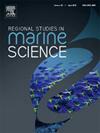Determination of body length regression formulas for the golden grey mullet (Chelon auratus, Risso 1810) based on otoliths found in the feces of the Caspian Seal (Pusa caspica Gmelin, 1788)
IF 2.1
4区 环境科学与生态学
Q3 ECOLOGY
引用次数: 0
Abstract
The Caspian Seal (Pusa caspica), the sole marine mammal endemic to the Caspian Sea, is listed in the IUCN Red List as a species facing the threat of extinction, a status similarly recognized and/or assigned in all countries in the Caspian region. The study of seal nutrition using caprological methods is of great interest for understanding animal adaptation to deteriorating habitat conditions and assessing the adequacy of their food base in the sea. This method involves analyzing the contents of feces from ichthyophages to detect undigested fish otoliths. The results of studying the seal's diet during periods of haulout on breeding grounds showed that the frequency of occurrence of Chelon auratus otoliths ranged from 2 % to 3–27.7 % of all fish otoliths detected in feces. This study aims to assess changes in Chelon auratus otoliths as they pass through seals' gastrointestinal tracts and estimate formulas for recovering the linear dimensions of fish consumed by these seals. The research indicates that otolith growth slows with fish growth but does not cease entirely. Allometry is evident in the different ratios of otolith length and width to fish length in various size groups and the change in otolith shape as fish grow. To recover the body length of fish consumed by seals based on otoliths found in their feces, applying inverse calculation formulas obtained when studying the relationship between otolith growth and fish body growth using collection material obtained directly from fish is possible. Further research should focus on refining the recovery formula for the length of large fish by dividing the length into several segments, each described by separate formulas describing the relationship between fish body length and otolith length and width growth.
根据在里海海豹(Pusa caspica Gmelin,1788 年)粪便中发现的耳石确定金灰鲻(Chelon auratus,Risso 1810 年)的体长回归公式
里海海豹(Pusa caspica)是里海特有的唯一海洋哺乳动物,被世界自然保护联盟(IUCN)红色名录列为面临灭绝威胁的物种,里海地区的所有国家都承认和/或给予了类似的地位。利用毛细管学方法研究海豹的营养状况,对于了解动物对日益恶化的栖息地条件的适应性以及评估其在海洋中的食物基础是否充足具有重要意义。这种方法是通过分析鱼栉水母的粪便内容物来检测未消化的鱼耳石。对海豹在繁殖地栖息期间的饮食进行研究的结果表明,在粪便中检测到的所有鱼类耳石中,栉水母耳石的出现频率从 2% 到 3-27.7% 不等。本研究旨在评估海豹耳石在通过海豹胃肠道时的变化,并估算恢复海豹食用鱼类线性尺寸的公式。研究表明,耳石的生长会随着鱼的生长而减缓,但不会完全停止。不同体型组的耳石长度和宽度与鱼体长度的比例不同,耳石形状也随着鱼体的生长而发生变化,这些都表明了耳石的异构性。要根据海豹粪便中的耳石恢复海豹食用鱼的体长,可以利用直接从鱼身上获取的采集材料,应用在研究耳石增长与鱼体增长之间关系时获得的反向计算公式。进一步研究的重点应该是完善大型鱼类体长的恢复公式,将体长分为若干段,每段由描述鱼体长度与耳石长度和宽度增长之间关系的单独公式来描述。
本文章由计算机程序翻译,如有差异,请以英文原文为准。
求助全文
约1分钟内获得全文
求助全文
来源期刊

Regional Studies in Marine Science
Agricultural and Biological Sciences-Ecology, Evolution, Behavior and Systematics
CiteScore
3.90
自引率
4.80%
发文量
336
审稿时长
69 days
期刊介绍:
REGIONAL STUDIES IN MARINE SCIENCE will publish scientifically sound papers on regional aspects of maritime and marine resources in estuaries, coastal zones, continental shelf, the seas and oceans.
 求助内容:
求助内容: 应助结果提醒方式:
应助结果提醒方式:


